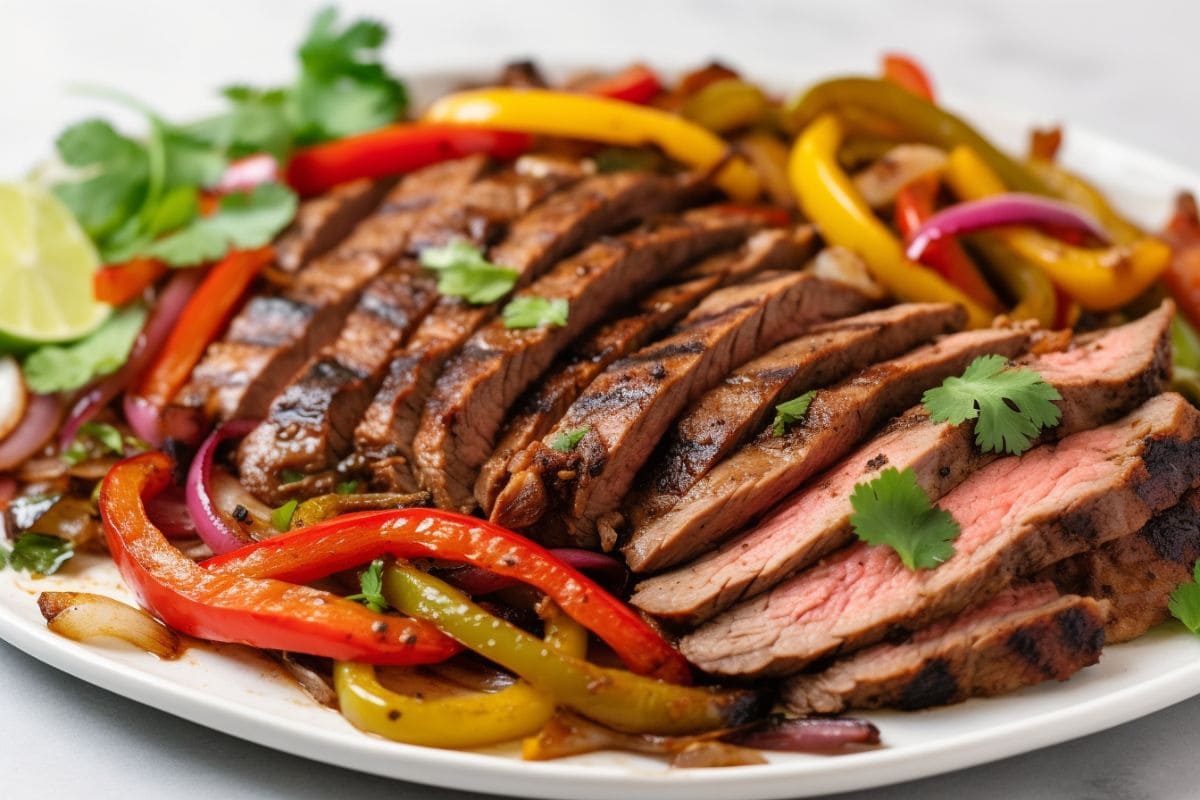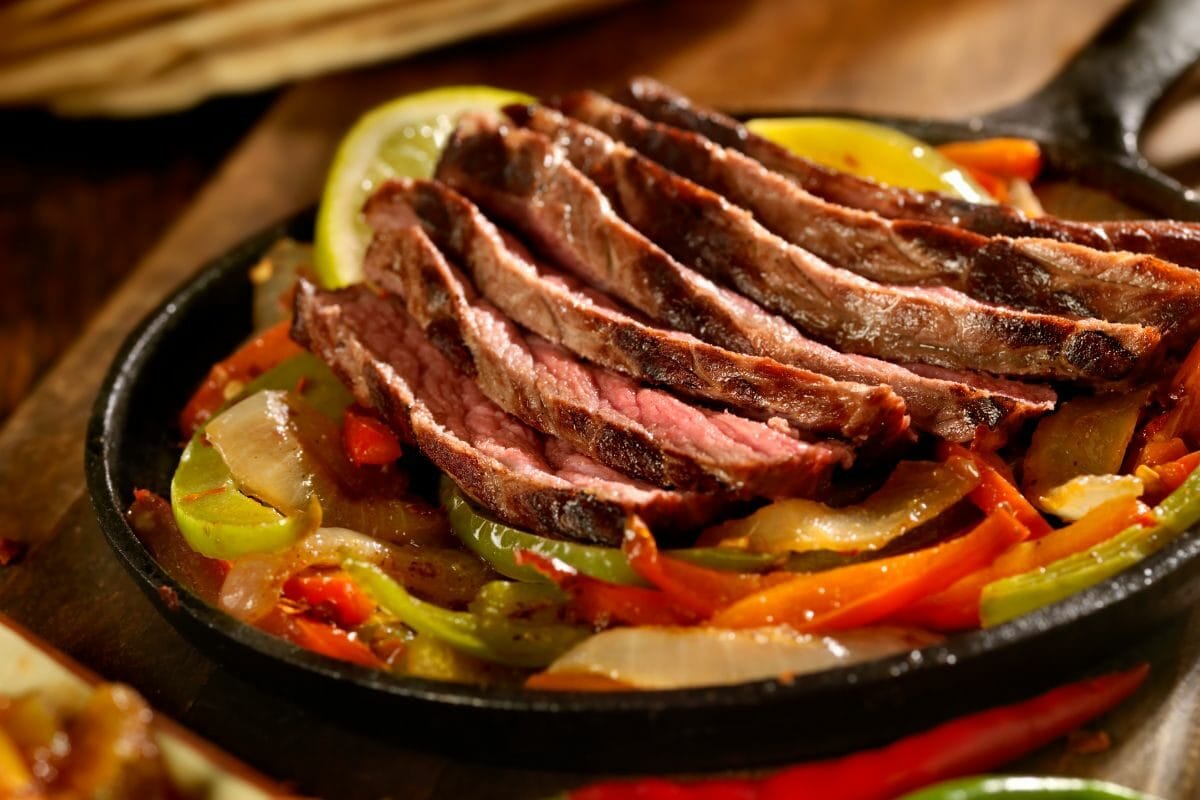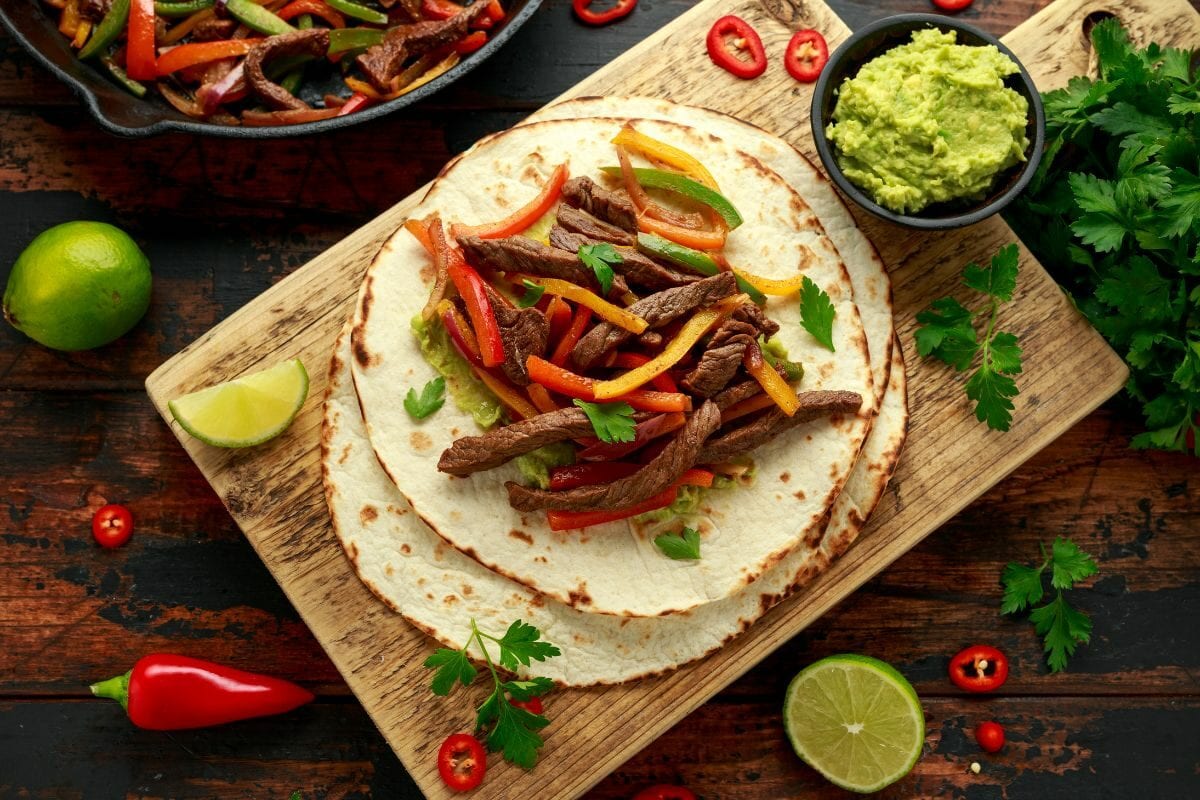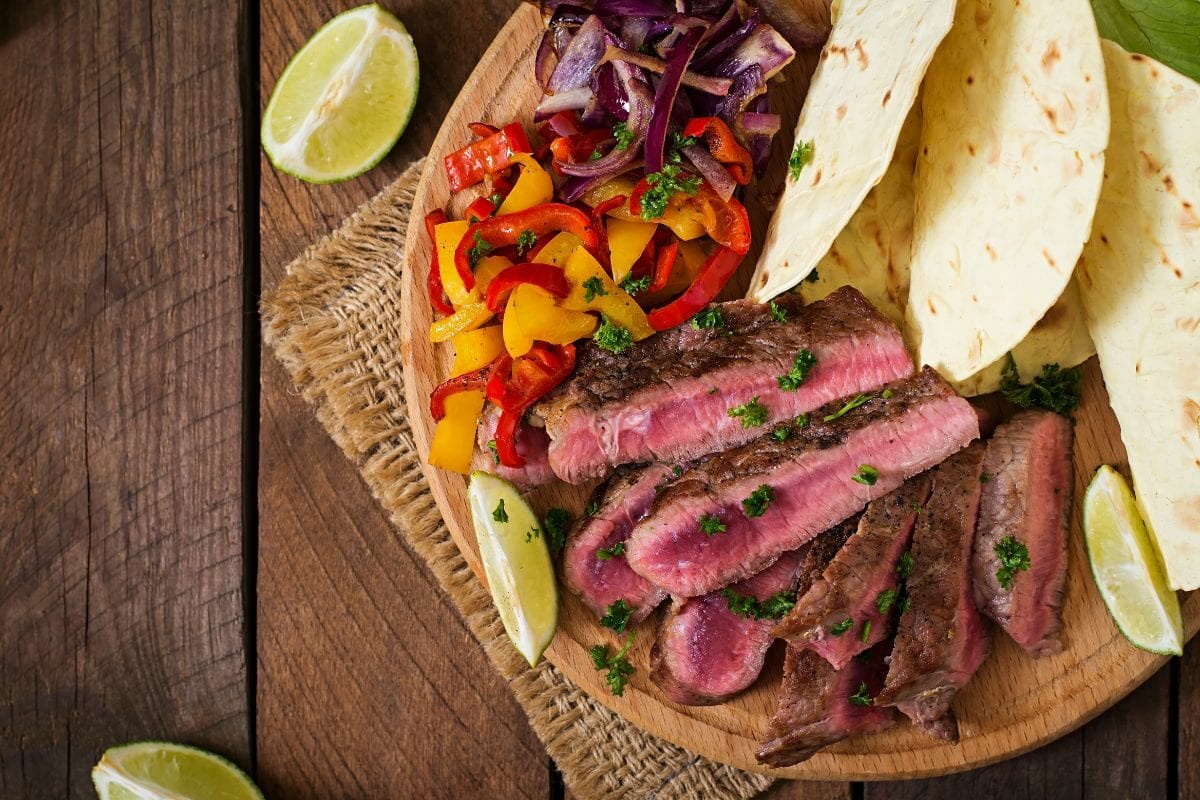I think skirt steak is the best cut of steak for fajitas. It cooks fast over a hot grill, can soak up a marinade with ease (if you’re using one), and it’s meltingly tender and with a rich, beefy flavor.
Fajita night at my house is a weekly event, and there’s not a cut of beef I haven’t tried to turn into fajita meat. I’ll cover all my other favorite cuts, what I like about them, what temperature to cook your beef to, and more. I’ve even thrown in my favorite fajita recipe.
Let’s take a closer look at the best cuts of steak for fajitas. I’ve got answers to all your pressing questions. Say adios to bland fajitas and hola to deliciousness.

I’ve started with my favorite cut, the skirt steak, and worked my way down in order of preference. As you’ll see, the names of cuts can vary by region: when in doubt about the cut, ask your butcher.
Skirt steak is my ideal candidate for beef fajitas. It comes from the bottom front of the cow, between the brisket and the flank. When cooked correctly, it’s rich and supremely tasty.
While still an economical cut of meat, skirt steak prices have risen in recent years. If skirt steak is out of your budget, flank, hanger, and flap steak are still excellent options.
Related Reading
Flank steak is another popular cut of meat for fajitas.
Flank steak has a robust, beefy flavor which makes it great for fajitas. However, it can be a bit tough – make sure you follow my tips to maximize your flank steak’s tenderness.
Related Reading
The giant hanger steak is also a popular cut of meat for fajitas. It’s not as tough as a flank or skirt steak, but it’s more expensive.
It’s also called an arrachera in South Texas. But in some parts of Mexico and some parts of this country, they actually call this cut a fajita.
Flap meat is another popular fajita meat. In South Texas, this cut of beef is called sirloin fajitas. Some places call it a “bavette.” In Mexico, it’s known as “arrachera.” It’s also called a “ranchera” in Arizona and New Mexico.

If you ask the Mexicans or Texans, they’ll tell you it’s because these cuts are inexpensive. They also soak up marinades well, and when thinly sliced across the grain, they get super tender and flavorful.
While many other cuts of beef, such as sirloin, top round, sirloin tip, sirloin flap, London broil, and flat iron steaks are also used for fajitas, I’d avoid them. These are not ideal for fajitas.
I like them all – I’m a beef-loving San Franciscan. But my top pick is skirt steak – it’s the traditional choice and has been used in delicious beef fajitas for decades.
I also like flank steak, as it’s easy to find at the store and it’s easy to cook.
While the cut of beef you select is important, so is how you cook it. Cooking the beef over a hot fire (500°F) and to the correct temp (125°F for medium-rare) will make your fajitas absolutely sizzle. Slicing against the grain will make beef less chewy and divinely tender.
Follow my cooking methods for fajitas that will have your dinner guests begging for mas.
I aim for around 500°F. These cuts of meat are ideal when cooked quickly over a ripping hot grill.
Nothing will ruin your dinner like beef that’s been cooked past medium. It’ll be tough as shoe leather. You’re looking for tender beef, not beef jerky.
Monitor the internal temperature of your beef with a good instant-read thermometer. Aim for 125°F for medium-rare (which is what I cook my fajita beef to) and 135°F for medium.
All the cuts mentioned in this article have a lot of muscle fibers. They’re economical cuts of meat for a reason – these muscles get used more than others and are tougher than the less used muscles of the cow.
One way to make the cuts seem more tender is by slicing the beef thinly against the grain. Inspect your steak, and note the direction of the grain that the fibers run. Cutting the steak at a 90-degree angle across the grain into 1/4” strips will make it easier to chew.
Now, before you go, I’d like to show you my recipe for an original fajita made out of skirt steak.
I’ll be using skirt steak for this original fajita recipe. You’re free to use a flank, hanger, or flap steak. Let’s get fired up.
Note: This recipe calls for a “plancha,” flattop-style grill to cook on. Similar cookers, like the popular Blackstone flattop, would also work. You could also use a cast iron pan or a sheet pan placed on top of the grates of your gas or charcoal grill.
Makes 12 servings

Get your plancha flat top grill fired up and hot. I shoot for around 500°F – this is a screaming hot temperature that will sear your beef beautifully. If you have two burners, set one to high heat and the other to low heat. Use the high heat side to cook on, and use the side with lower heat as a warmer.
The first step is to have the skirt steak trimmed up and cut. Specifically, you should the steak lengthwise into about two-and-a-half-inch thin strips.
Next, cut the steak into bite-sized strips across the grain. They’re going to shrink a little as they cook. A sharp knife and cold meat make the job much quicker and easier.
Once your steak is cut into thin strips, season it with 2.5 tablespoons of your favorite fajita seasoning.
Veggies give fajitas a bright pop of color and a delightful crunch. A Roma tomato will be great if you can find one, but other tomatoes will work, too. Some people don’t use tomatoes in their recipes, but I like tomatoes on my sizzling platter.
Dice the tomatoes into 1/4” chunks. Julienne your peppers and onions into long, thin strips.
Season your veggies with the remaining tablespoon of seasoning.
Add a little cooking oil to the plancha. Regular old vegetable oil works great, but so will any other cooking oil. A tablespoon is enough.
Throw some diced onions on the side of the plancha that’s hot. I like to put the onions on first, ahead of the other veggies. They take a little longer to get soft. Keep turning them so they don’t burn. Do this for about 30 seconds or maybe a minute.
After that, get the peppers on the hot side of the grill. Cook for a couple of minutes, until they’ve softened and have darkened. Move all the veggies to the cooler side of the grill.
Note: if you don’t have a warming burner, place your veggies on a plate and cover them with foil. They’ll stay nice and hot while the beef is cooking.
Now, get that beef on the plancha. If the grill surface looks dry, add a little more oil. As you drop the slices on, they should make a nice sizzle. Spread the pieces out a little bit first.
Keep the meat moving because that plancha will be very hot – you don’t want the beef to burn.
The thin strips of beef will cook quickly – likely in under five minutes. Check the temp with an instant-read thermometer. You’re shooting for 125°F for medium rare. If you don’t have an instant-read thermometer, you can cut it into a strip – medium rare beef will be a rosy pink color.
Once the meat is done, go ahead and mix the veggies and beef together. Add the tomatoes. Turn off the heat.
It’s time to get the tortilla warmed up. Gather the meat and veggies off to the warming side and place the tortillas on the plancha so they can warm up. Add a little bit of oil before throwing the tortillas on.
Let the tortillas cook for around thirty seconds per side.
Scoop up some beef and veggies on top of the warmed flour tortilla. You can add salsa, pico de Gallo, creme fréche, squeezed lime juice, or any of your favorite toppings on top of the fajitas. Feast on the delicious meal you’ve grilled.

I prefer skirt steak over flank steak for fajitas because it’s great for searing. It’s also the traditional cut for classic steak fajitas. That said, they are similar cuts of meat, and both will make fantastic steak fajitas.
Outside of the US, skirt steak is also known as arrachera, Romanian tenderloin, Philadelphia steak, or Romanian steak.
Yes, you should cut the steak thinly before cooking. Also, it should be sliced across the grain to maximize tenderness.
The skirt steak is the authentic fajita steak, but you can also use a flank, flap, or hanger steak.
The good thing about this recipe is that it’s easy to cook. Buy a steak, and chop it across the grain. Keep the grill hot, then sear it, and wow!
Serve your steak fajitas with a warm tortilla, some lime wedges, and any other toppings you like. The mouthwatering combination is a treat you’ll keep coming back for.